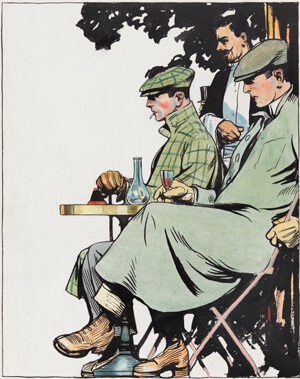Joséphine de Beauharnais: Patron of the Arts
Joséphine de Beauharnais was born in Martinique as Marie Josèphe Rose Tascher de La Pagerie. She evolved into the sophisticated and cultured...
Maya M. Tola 20 May 2024
If you’ve seen the painting titled Nighthawks, chances are you are slightly familiar with the work of 20th-century American Realist artist, Edward Hopper. He is known for his realistic paintings that showcase the themes of isolation or mystery. He used the space on the canvas and shadows to create a feeling of melancholy. We can see this over and over again in his other paintings, such as Automat (1927), or New York Movie (1939). Furthermore, within this melancholic sense of isolation, Hopper depicted urban and architectural scenes within his contrasted dark palettes such as Captain Upton’s House (1927), or New York Corner (1913). But beyond the success of his oil paintings, Hopper worked for roughly two decades as an illustrator.
The New York-based artist has been referred to as “the supreme American Realist of the 20th century.” Although his paintings totaled roughly 800, it is said that painting did not come as easy to Hopper as one may think when one sees his work. Something that may have come easier? Illustration. Hopper spent quite some time as a professional illustrator. The artist was encouraged to take up illustrating as a means of financial security. With his illustrations and etchings, Hopper found early artistic, albeit commercial, success. His earnings from his commercial jobs allowed him to travel overseas to Europe to learn more from the artists and museums there.

Edward Hopper, Men Seated at Cafe Table, 1906, Whitney Museum of American Art, New York, NY, USA. Norman Rockwell Museum.
One 20th-century art critic for Time magazine interviewed Hopper for the artist’s cover feature in 1956. In the article, Alexander Eliot presented the artistic styles and capabilities of the American artist: it seemed that the way he saw the painting and the sense of responsibility in having a paycheck was what spurred him to keep pressing on with his painting.
To Eliot’s credit, 60 years later, art historians still struggle to reconcile the most sensational of Hopper’s commercial illustrations with the quiescent scenes that earned him a place among the great 20th-century artists.
Literary Hub, 2018.
This variance in styles showcases something seen repeatedly: this period allowed him to grow as an artist while appealing to a broader audience as an illustrator.
In 2014, The Norman Rockwell Museum put on an exhibition titled The Unknown Hopper: Edward Hopper as Illustrator. The exhibit was a look into Hopper’s little-known 20-year career as an illustrator. One of the first things they say is that “Hopper sells.” It is a fact. Hopper’s works have been steadily received since their origination.
But that statement reflects in his oil paintings. In 2018, a 1929 painting titled Chop Suey, depicting two women talking in a restaurant, sold for a whopping $91.9 million. What happened to his illustrations?
The exhibit’s purpose was to shine a light onto a part of his life that had been forgotten or many of us were not aware of before. In the interview with Alexander Eliot, it is revealed that plenty of his illustrations and even his time as an illustrator, connections to his teachers, and much of his life were kept hidden away by the artist himself.
By its definition, an illustration can be more than what we have seen here. The drawings shown are just a small part of what Hopper completed in his career. Check out another DailyArt Magazine article on Hopper’s sketches and drawings.
Daniel Crown, “The Unlikely Pulp Fiction Illustrations of Edward Hopper.” Literary Hub, 2018.
“The Architecture of Edward Hopper.” Slate. 2008.
The Norman Rockwell Museum. “Edward Hopper.“
The Norman Rockwell Museum. “The Unknown Hopper: Edward Hopper as an Illustrator.”
DailyArt Magazine needs your support. Every contribution, however big or small, is very valuable for our future. Thanks to it, we will be able to sustain and grow the Magazine. Thank you for your help!